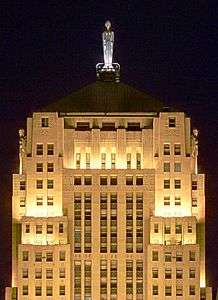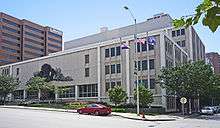CME Group
CME Group Inc. (Chicago Mercantile Exchange, Chicago Board of Trade, New York Mercantile Exchange, The Commodity Exchange) is a global markets company.[3] It is the world's largest financial derivatives exchange,[4] and trades in asset classes that include agricultural products, currencies, energy, interest rates, metals, and stock indexes. The company offers futures contracts and options on futures using its CME Globex trading platforms,[5][6] fixed income trading via BrokerTec and foreign exchange trading on the EBS platform. In addition, it operates a central counterparty clearing provider, CME Clearing. With a range of pre- and post-trade products and services underpinning the entire lifecycle of a trade, CME Group also offers optimization and reconciliation services through TriOptima, and trade processing services through Traiana.
| Public | |
| Traded as | NASDAQ: CME (Class A) S&P 500 Component |
| ISIN | US12572Q1058 |
| Industry | Financial Services |
| Founded | 1848 (oldest exchange Chicago Board of Trade) |
| Headquarters | Chicago, Illinois, United States |
Key people | Terrence A. Duffy (Chairman & CEO) John W. Pietrowicz (CFO) |
| Revenue | |
| Total assets | |
| Total equity | |
Number of employees | 4500[1] (2020) |
| Subsidiaries | Chicago Mercantile Exchange Chicago Board of Trade New York Mercantile Exchange Commodities Exchange, Inc. NEX Group Kansas City Board of Trade S&P Dow Jones Indices (27.0% ownership) |
| Website | www |
| Footnotes / references [2] | |
The company has been described by The Economist as, "The biggest financial exchange you have never heard of".[7] In 2019, CME Group was named the world's fastest growing and most valuable exchange brand for the sixth consecutive year by Brand Finance, while it had the fifth greatest brand strength.[8]
Trading platforms
Trading is conducted in two methods: an open outcry format and the CME Globex Trading System which is an electronic trading platform.
Open outcry
Operating during regular trading hours (RTH), the open outcry method consists of floor traders standing in a trading pit to call out orders, prices, and quantities of a particular commodity or its derivatives. Different colored jackets are worn by the traders to indicate what firm they are a part of. In addition, complex hand signals (called Arb) are used. These hand signals were first used in the 1970s. Today, however, headsets are also used by the brokers to communicate with the traders. The pits are areas of the floor that are lowered to facilitate communication, somewhat like a miniature amphitheater. The pits can be raised and lowered depending on trading volume. To an onlooker, the open outcry system can look chaotic and confusing, but in reality the system is a tried and true method of accurate and efficient trading. An illustrated project to record the hand signal language used in CME's trading pits has been compiled.[9]
.jpg)
Electronic trading
Operating virtually around the clock, today the CME Globex trading system is at the heart of CME Group. Proposed in 1987, it was introduced in 1992 as the first global electronic trading platform for futures contracts. This fully electronic trading system allows market participants to trade from booths at the exchange or while sitting in a home or office thousands of miles away. On October 19, 2004, the one billionth (1,000,000,000) transaction was recorded. Today, CME Globex operates 24 hours a day, six days a week. More than 90 percent of total volume at the exchange occurs electronically on CME Globex.
Eurodollar trading
CME Group announced on August 10, 2020 that it will reopen its trading pit for the Eurodollar options. The company will be reconfiguring the pit to meet social distance standards over the next few weeks and implement additional security measures. While the coronavirus problem remains dynamic, the company will continue to track the situation and convey any adjustments when appropriate. The other open outcry exchange pits must stay locked until Phase 5 of their reopening efforts is completed by the City of Chicago and Illinois State.[10]
Global footprint
In 2019, CME Group’s non-U.S. average daily volume reached a record 4.9 million contracts, up 10% compared with 2018, including 7% growth in Europe, 20% growth in Asia and 47% growth in Latin America. In addition to maintaining offices across the Americas, Europe and Asia, the company also partners with other global exchanges including Bursa Malaysia Berhad, The Dubai Mercantile Exchange and Singapore Exchange Limited.[11]
Awards and Honors
CME Group has received numerous industry awards. The company was named Exchange of the Year, Clearing House of the Year and Exchange Innovation of the Year in the 2019 Risk Awards. CME Group won in four categories at the FOW International Awards including Global Exchange of the Year, Americas Exchange of the Year, Best New Interest Rates Contract and Proprietary Traders' Exchange of the Year. In 2019, CME Group was named to the Forbes list of America’s Best Mid-Size Employers.[12] CME Group was also named to Computerworld's 2019 Best Places to work in IT list.[13] In 2019, the company earned a perfect score of 100 on the Human Rights Campaign’s Corporate Equality Index.[14]
CME Span
The company pioneered the CME SPAN software that is used around the world as the official performance bond (margin) mechanism of 50 registered exchanges, clearing organizations, service bureaus, and regulatory agencies throughout the world. In 2019, CME Group announced that it would launch the next generation of CME Span Margin Methodology (CME Span 2) in the first half of 2020, pending regulatory approval.[15]
Mergers and acquisitions
On October 17, 2006, The Chicago Mercantile Exchange announced a merger with its historic rival the Chicago Board of Trade for $8 billion in stock, joining the two financial institutions as CME Group Inc. The merger agreement was modified on December 20, 2006,[16] May 11, 2007,[17] June 14, 2007[18] and on July 6, 2007.[19] The merger was approved by shareholders of both CME and the Chicago Board of Trade on July 9, 2007.[20] and closed on July 12, 2007, after which the Chicago Board of Trade shares (old symbol: BOT) stopped trading and were converted into CME shares as agreed, and the overarching holding company began life as CME Group, a CME/Chicago Board of Trade Company.[21] On January 13, 2008 electronic trading at the Chicago Board of Trade shifted to CME Globex.[22]
On March 17, 2008, New York Mercantile Exchange (NYMEX) (owner of both the NYMEX exchange and the COMEX exchange) accepted an offer from CME Group, to purchase NYMEX for $8.9 billion in cash and CME Group Stock.[23] The acquisition was formally completed on August 22, 2008, and the NYMEX systems were fully integrated by September 30, 2009.[24] Also in 2007, NYMEX in a joint venture with partners on the Arabian Peninsula opened the Dubai Mercantile Exchange (DME).[25]
On February 10, 2010, CME announced its purchase of 90% of Dow Jones Indexes, including the Dow Jones Industrial Average.[26] CME subsequently contributed Dow Jones Indexes to the formation of S&P Dow Jones Indices in exchange for a 24.4% ownership interest.[27] In April 2013, CME purchased the remaining 10% interest in Dow Jones Indexes for $80.0 million. As a result, CME's interest in S&P Dow Jones Indices increased from 24.4% to 27.0%.[28]
On October 17, 2012, CME Group announced it would acquire the Kansas City Board of Trade for $126 Million in cash. KCBOT was the dominant venue for the sale of hard red winter wheat. The Chicago Board of Trade was the leading trade platform for soft red winter wheat.[29][30]
On March 29, 2018, CME Group announced that it was buying London-based NEX Group for $5.5 billion.[31] The acquisition was completed on November 2, 2018.[32][33]

 Chicago Board of Trade (CBOT)
Chicago Board of Trade (CBOT)- New York Mercantile Exchange (NYMEX) and COMEX
 Kansas City Board of Trade (KCBOT)
Kansas City Board of Trade (KCBOT).svg.png) S&P Dow Jones Indices (27.0% ownership)
S&P Dow Jones Indices (27.0% ownership)
See also
- Chicago Mercantile Exchange
- Intercontinental Exchange
- CME Group Titleholders, the season-ending tournament of the LPGA Tour of women's golf, sponsored by CME Group
- Chicago Board of Trade
- New York Mercantile Exchange
- NEX Group plc
References
- "CME Group". Fortune. Retrieved February 5, 2019.
- "US SEC: Form 10-K CME Group Inc". U.S. Securities and Exchange Commission. Retrieved February 15, 2018.
- Stafford, Phillip (May 9, 2019). "CME gains boost with new 'micro' futures contracts". The Financial Times. Retrieved May 13, 2019.
- "How Exxon, Chevron's suffering stock affects your 401(k)". Yahoo Finance. Fox Business. Retrieved February 28, 2020.
- "CME looks to the futures in Europe". Futures & Options World. June 3, 2014. Retrieved April 8, 2016.
- "London stock exchange welcomes CME group to celebrate its global partnership with FTSE Russell". Lseg.com. Retrieved January 21, 2019.
- "CME Group: The futures of capitalism". The Economist. May 11, 2013. Retrieved April 8, 2016.
- "CME is World's Most Valuable Exchange Brand for Sixth Year Running". Brand Finance. Retrieved February 24, 2020.
- "CME Trading Pit Hand Signals History". tradingpithistory.com. Retrieved August 16, 2011.
- "CME Group to Reopen Eurodollar Options Trading Pit on August 10". Cision PR Newswire. June 9, 2020. Retrieved June 16, 2020.
- "CME Group Inc. Reports Fourth-Quarter and Full-Year 2019 Financial Results". press release. Retrieved February 24, 2020.
- "America's Best Midsize Employers". Forbes. Retrieved June 3, 2020.
- King, Julia (June 17, 2019). "Best Places to Work in IT 2019". Computerworld. Retrieved June 3, 2020.
- "58 companies in Illinois were named LGBTQ friendly". WICS. January 21, 2020. Retrieved June 3, 2020.
- "CME Group to Launch Next Generation of CME SPAN Margin Methodology". press release. Retrieved February 24, 2020.
- "Merger agreement modified December 20, 2006".
- "Merger agreement modified May 11, 2007".
- "Merger agreement modified June 14, 2007".
- "Merger agreement modified July 6, 2007".
- "Merger agreement passed July 9, 2007".
- "CME Group began operations July 13, 2007".
- Saphir, Ann (March 3, 2008). "Trading Places". Crain's Chicago Business. Crain Communications Inc.
- "CMEgroup.com". Cmegroup.mediaroom.com. Retrieved September 22, 2012.
- "CMEgroup.com". Investor.cmegroup.com. Retrieved September 22, 2012.
- "DME: Dubai Mercantile Exchange Strategic Partnership". www.cmegroup.com. Retrieved June 6, 2019.
- Berman, Dennis K.; Mccracken, Jeffrey (February 11, 2010). "CME Buys 90% of Dow Jones Indexes". The Wall Street Journal.
- Leising, Matthew (July 2, 2012). "McGraw-Hill, CME Group Start S&P Dow Jones Indices Venture". Bloomberg. Retrieved December 6, 2013.
- "CME 10-K for the Fiscal Year Ended December 31, 2014". February 26, 2015. Retrieved June 8, 2018.
- "CME Group to Acquire Kansas City Board of TradePrint" (Press release). Chicago / Kansas City, Missouri. October 17, 2012. Retrieved April 8, 2016.
- "CME Group wraps up $126M acquisition of Kansas City Board of Trade". www.bizjournals.com. December 3, 2012. Retrieved March 5, 2019.
- "CME Group agrees to buy Michael Spencer's Nex for £3.9bn". Financial Times. March 29, 2018.
- "CME Group acquires Nex". November 2, 2018.
- Sahloul, Fareed. "UK competition regulators clear CME's takeover of NEX". www.fnlondon.com. Retrieved March 5, 2019.
External links
- Business data for CME Group:
- The CME Group Collections at University of Illinois at Chicago